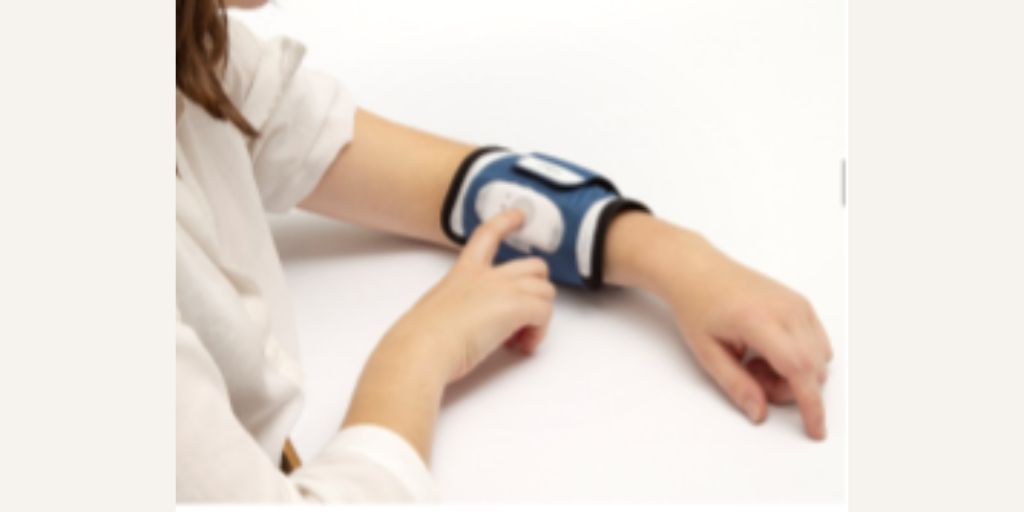
Mdoloris, specialist in medical pain monitoring technologies, unveils ANI Guardian, the first connected bracelet to track the wellbeing and pain of people that cannot express it. The bracelet miniaturizes a patented technology that was until now only available in hospitals. Reliable, continuous, and non-invasive, it remotely shares data to caregivers, family and medical specialists in real time. Ideal for both indoor and outdoor use, the wireless bracelet features a 24 continuous monitoring for a 1-hour charge, needs no installation and eases the lives of patients under care. It will revolutionize the life of tens of millions of people at hospital, in retirement home or simply at home.
According to the WHO, an estimated 55 million people all over the world are suffering from a form of dementia, including Alzheimer’s disease. These patients are often unable to self-report their level of pain and comfort, which places them at increased risk for under-diagnosed and under-treated pain. This also concerns people on the autistic spectrum, in palliative care or suffering from multiple disabilities. The Mdoloris upcoming smart bracelet may soon change that. Easy to use and to install, it replaces current methods like comfort scales with an objective, easy to use, wearable device.
ANI Guardian seeks to measure the wellbeing of non-verbal patients in a non-invasive and easily understandable manner. Building on prior Mdoloris pain monitoring products which have been successfully used in hospitals (such as La Paz in Madrid, Spain, for a study on video games and cancer), it uses signals from the nervous system to accurately track and display the patient’s pain and comfort levels at all times, removing the subjectivity of pain measurement for non-verbal patients.
Fabien Pagniez, CEO and founder of Mdoloris, stated “With our connected bracelet, we wanted to democratize and simplify a technology that was up until now only used in hospitals. This wireless, wearable sensor is worn by the patient like a bracelet while using our unique indicator, the parasympathetic tone. We wish to address people suffering from strong cognitive disorders such as Alzheimer’s, on the autism spectrum or people at the end of life. It regards all those who have lost the ability to communicate to ensure that they are comfortable and maintain their dignity”.
How does it work?
Attached to a washable and reusable textile solution, the device is easy to set up, with only one button to turn it on and off, while charging it for an hour is sufficient for a full day’s use. The data from the bracelet is sent via Bluetooth to an allied smartphone application, allowing caregivers to easily track data history and progression over time. Physicians can also set automatic alarms if a patient’s comfort drops below a certain range. The bracelet’s multi-user technology also allows for use on multiple patients, for example in hospital or clinic settings.
A technology for patients and physicians alike
Pending launch, the prototype is already in use in Lille and Strasbourg, where the Geprovas are using the technology to monitor surgeons during training and/or a surgery.
This can open up further vistas for medical professionals and other high-stress professions, allowing them to provide even better care while minimizing stress.
Mdoloris, assessing wellbeing: from hospitals to home care
The connected bracelet miniaturizes the ANI technology which is already used in hospitals worldwide. In fact, it is the first time that such technology is available to everyone in such an accessible form. Having been the subject of more than 200 international publications, the ANI technology monitors pain and displays it in real-time on a screen to help avoid under or overdosing, by enabling doctors to give the right dosage. Previously, the Mdoloris ANI device was deployed in Brazil and other countries to predict the survival rate in COVID19 patients. Days in advance, doctors can evaluate if a patient is going to die with standard care. The MDoloris technology offers them the possibility to explore other care solutions. In the context of the pandemic, it’s also a solution to the painkiller shortage by helping personalize their analgesics treatment.
Availability
The connected bracelet is expected to be available worldwide by June 2023.
The science behind the Mdoloris ANI index
The Mdoloris technology measures Heart Rate Variability, a well-known phenomenon that controls the regulation of the cardiovascular system via the Autonomous Nervous System. It’s based on obtaining a Parasympathetic tone index, scientifically evaluated on a numerical value between 0 and 100. A high index reflects optimal comfort while a rather low index reveals discomfort, surgical stress that can be caused by the care performance, can lead to post-operative pain, inflammation response etc. This index is calculated from a proprietary ANI sensor provided to monitor pain in a comfort zone between 50 and 70. The ANI technology has been developed after more than 23 years of academic research conducted at Lille CHRU (one of France’s major hospitals and medical research facilities) and hundred publications. MDoloris has also developed specific pain monitoring devices for newborns (NIPE) and animals (PTA).



